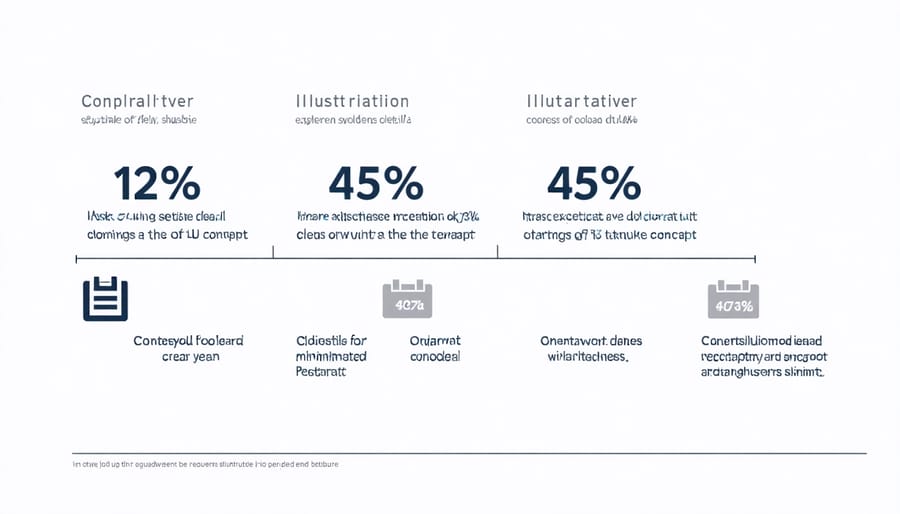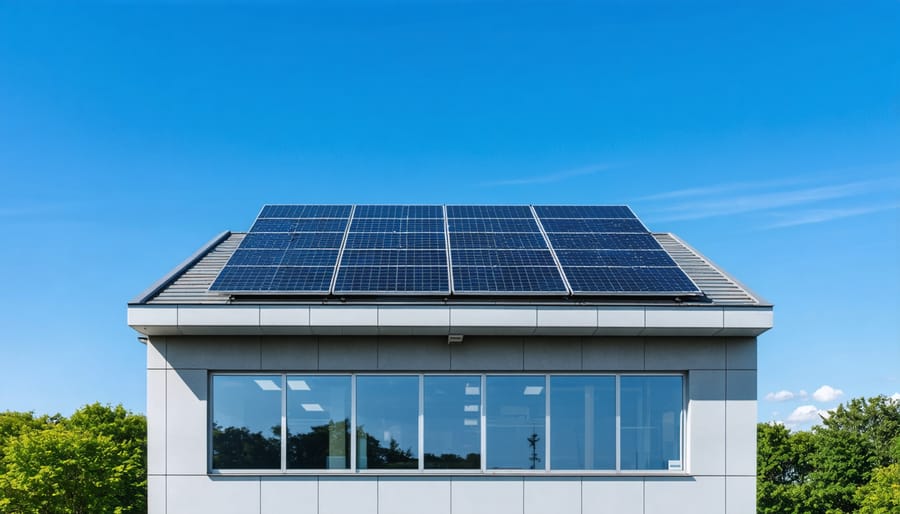Business Solar Tax Breaks That Actually Put Money Back in Your Pocket
Transform your business’s bottom line with solar energy incentives that deliver immediate financial returns while contributing to a sustainable future. Today’s commercial solar investments offer unprecedented tax benefits for businesses, including federal tax credits covering up to 30% of installation costs, accelerated depreciation benefits, and state-specific rebates that can slash initial expenses by 50% or more.
Smart business owners are leveraging these incentives to achieve payback periods as short as 3-5 years, while securing energy independence and protecting against rising utility costs. With commercial electricity rates climbing annually, solar installations now deliver average returns on investment exceeding 20% – outperforming many traditional business investments.
The current landscape of business solar incentives has never been more favorable, thanks to the Inflation Reduction Act’s enhanced tax credits, local grant programs, and performance-based incentives that provide ongoing revenue streams. Whether you’re a small retail operation or a large industrial facility, these programs make solar adoption not just environmentally responsible, but financially imperative for forward-thinking businesses.
Federal Solar Investment Tax Credit (ITC)

How Much Can Your Business Save?
Understanding your potential savings with solar investment starts with the Investment Tax Credit (ITC). To calculate your potential savings, multiply your total solar installation cost by the current 30% ITC rate. For example, a $100,000 solar system could earn you $30,000 in federal tax credits alone.
But that’s just the beginning. Your business can save significantly through:
• Reduced monthly utility bills (typically 50-75% lower)
• Local tax incentives and rebates
• Accelerated depreciation benefits
• Net metering credits
• Performance-based incentives
Let’s break down a realistic scenario: A medium-sized business installing a $250,000 solar system could expect:
• Federal ITC savings: $75,000
• Annual energy savings: $30,000-$45,000
• Depreciation benefits: $50,000-$70,000
• State/local incentives: $10,000-$25,000
Most businesses see complete system payback within 3-7 years, after which the energy savings become pure profit. With solar panels lasting 25-30 years, your business could save hundreds of thousands of dollars over the system’s lifetime while significantly reducing its carbon footprint.
Remember, these are general estimates, and your actual savings will depend on factors like energy usage, location, and available local incentives.
Qualification Requirements
To qualify for the Business Solar Investment Tax Credit (ITC), your company must meet several key requirements. First, your business needs to be located in the United States and have a tax liability – you must owe taxes to claim the credit. The solar system must be new or being used for the first time, and your company must own the system outright rather than lease it.
Your solar installation must be completed and operational within the tax year you’re claiming the credit. The system should be installed on a commercial property you own or on a building where you conduct business operations. If you’re a tenant, you’ll need written permission from the property owner.
The solar equipment must meet all applicable safety and performance standards, including those set by the American Society for Testing and Materials (ASTM). Your installation must be completed by a certified solar professional to ensure compliance with local building codes and regulations.
Additionally, your system must generate electricity for your business use. While you can send excess power back to the grid through net metering programs, the primary purpose should be to offset your company’s electricity consumption.
Keep detailed records of all expenses related to your solar installation, including equipment costs, labor, and permits. These documents will be essential when claiming the tax credit and during any potential IRS audit.
Remember that these requirements may change over time, so it’s advisable to consult with a tax professional before proceeding with your solar investment.
State-Specific Business Solar Incentives

Performance-Based Incentives
Performance-based incentives (PBIs) reward businesses based on their solar system’s actual energy production, offering a direct financial benefit for maintaining efficient operations. These incentives typically pay a fixed amount per kilowatt-hour (kWh) of electricity your solar panels generate, creating a steady revenue stream that can last for several years.
Many utility companies and state programs offer PBIs through mechanisms like feed-in tariffs or production-based rebates. For example, some programs might pay $0.05 to $0.15 per kWh produced, which adds up significantly over time. A 100kW commercial system generating 160,000 kWh annually could earn $8,000 to $24,000 per year in PBI payments alone.
To qualify, your system must typically include approved monitoring equipment that tracks and reports energy production. Regular maintenance is crucial to maximize these benefits, as payments are directly tied to system performance. Some programs also offer bonus incentives for peak production periods or systems that exceed expected generation targets.
Remember that PBIs can work alongside other solar incentives, creating multiple revenue streams that improve your overall return on investment.
Equipment Rebates
Equipment rebates offer significant savings opportunities for businesses investing in solar technology, with programs varying by state and utility provider. For example, California’s Self-Generation Incentive Program (SGIP) provides rebates for solar equipment and energy storage systems, while New York offers equipment rebates through their NY-Sun program.
Many utility companies partner with state governments to offer additional rebate programs. These typically cover a portion of the equipment costs, ranging from 10% to 30% of the total investment. Some programs offer higher rebates for energy-efficient equipment or for businesses in designated development zones.
To qualify, businesses usually need to work with certified installers and use approved equipment that meets specific energy efficiency standards. Documentation requirements typically include detailed equipment specifications, installation plans, and energy consumption data.
Popular rebate-eligible equipment includes solar panels, inverters, mounting systems, and monitoring devices. Some programs even cover energy storage solutions like battery systems when installed alongside solar panels.
Remember to check both state energy offices and local utility providers for current rebate offerings, as programs and funding levels can change annually.

Accelerated Depreciation Benefits
One of the most significant financial advantages for businesses investing in solar energy is the Modified Accelerated Cost Recovery System (MACRS). This powerful tax benefit allows companies to depreciate their solar installations over just five years, even though the system typically lasts 25-30 years. This accelerated depreciation schedule can dramatically improve your solar investment returns by reducing your tax burden in the early years after installation.
Here’s how it works: Instead of spreading the depreciation evenly across the system’s lifetime, you can write off a larger portion of the investment during the first five years. The depreciation schedule follows a specific pattern: 20% in year one, 32% in year two, 19.2% in year three, 11.52% in year four, and 11.52% in year five, with the remaining 5.76% in year six.
For example, if your business installs a $500,000 solar system, you could potentially deduct $100,000 in the first year alone. This accelerated depreciation creates substantial tax savings during the crucial early years of your investment, effectively lowering the overall cost of your solar installation.
When combined with other incentives like the Investment Tax Credit (ITC), accelerated depreciation can help businesses recover a significant portion of their initial investment much faster than traditional depreciation methods would allow. This rapid cost recovery makes solar energy an increasingly attractive option for businesses looking to reduce both their carbon footprint and operating expenses.
Local Utility Incentives
Local utility companies often provide valuable incentives to businesses installing solar panels, making the switch to renewable energy even more financially attractive. These programs vary by region and utility provider, but they typically include performance-based incentives, rebates, and special solar-friendly rate structures.
Many utilities offer upfront rebates based on system size or expected energy production. For example, some companies provide $0.50 to $1.50 per watt of installed capacity, which can translate to thousands of dollars in immediate savings. Performance-based incentives reward businesses for the actual energy their systems generate, often paying a premium rate for solar electricity fed back into the grid.
Some utility providers have created special time-of-use rates that benefit solar customers. These rates align well with solar production patterns, allowing businesses to maximize their savings by using solar power during peak rate periods. Additionally, many utilities offer free energy audits and consultation services to help businesses optimize their solar installations.
To find available programs in your area, contact your local utility provider directly or check their website’s renewable energy section. Keep in mind that utility incentives often have limited funding and may operate on a first-come, first-served basis. It’s advisable to research and apply for these programs early in your solar planning process to ensure you don’t miss out on valuable savings opportunities.
Remember that utility incentives can be combined with federal and state programs, significantly reducing your overall solar investment.
The time to embrace solar energy for your business has never been better. With numerous federal, state, and local incentives available, businesses can significantly reduce their initial investment while securing long-term energy savings. By taking advantage of tax credits, grants, and rebate programs, you’re not just making a smart financial decision – you’re also positioning your company as an environmental leader in your community. The benefits extend beyond cost savings to include enhanced brand reputation, increased property value, and a reduced carbon footprint. Don’t let these valuable incentives go unclaimed. Start your solar journey today by exploring available programs in your area and consulting with solar professionals who can guide you through the process. Making the switch to solar is an investment in both your business’s future and our planet’s sustainability.











